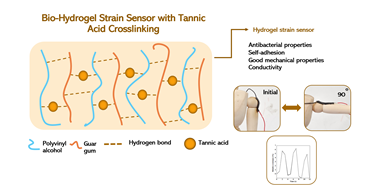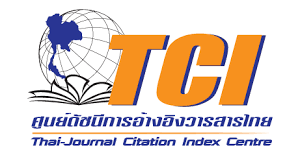Antibacterial, self-adhesive guar gum/polyvinyl alcohol/tannic acid conductive hydrogels for flexible strain sensors
DOI:
https://doi.org/10.55713/jmmm.v35i2.2290Keywords:
Strain sensor, Tannic acid, CrosslinkerAbstract
In this research, a multifunctional strain sensor with antibacterial properties and self-adhesion capabilities was developed using guar gum (GG), polyvinyl alcohol (PVA), and tannic acid (TA). The incorporation of TA into GG-PVA hydrogel-based strain sensors was investigated to evaluate its effects on mechanical and electrical properties, self-adhesion, and antibacterial activities. The anti-bacterial activities against Escherichia coli (E. coli) and Staphylococcus aureus (S. aureus) were enhanced with the increasing content of TA. The adhesive strength was observed in the range of 1.20 ± 0.10 kPa to 5.05 ± 0.23 kPa, and the values tended to increase as TA content increased. The tensile strength significantly increased by up to 86.66% when 1.5% TA was incorporated into the hydrogel, followed by a slight increase with the addition of TA at higher contents. Consequently, the hydrogel strain sensor with 1.5% TA was selected to evaluate its sensing capability for limb movement. The sample exhibited reproducibility and stability of the signals during repeated movements. These properties highlight the potential of strain sensors with multifunctional capabilities for applications in wearable electronic devices.
Downloads
References
Y. Zhang, G. Lu, C. Yan, J. Luo, X. Zhou, and J. Wang, “Fabrication of flexible accelerated-wound-healing chitosan/dopamine-based bilayer hydrogels for strain sensors,” International Journal of Biological Macromolecules, vol. 253, p. 127395, 2023. DOI: https://doi.org/10.1016/j.ijbiomac.2023.127395
G. Li, C. Li, G. Li, D. Yu, Z. Song, H. Wang, X. Liu, H. Liu, and W. Liu “Development of conductive hydrogels for fabricating flexible strain sensors,” Nano Micro small, p. 2101518, 2021. DOI: https://doi.org/10.1002/smll.202101518
C. Cui, Q. Fu, L. Meng, S. Hao, R. Dai, and J. Yang, “Recent progress in natural biopolymers conductive hydrogels for flexible wearable sensors and energy devices: Materials, structures, and performance,” Applied Bio Material, no. 4, p. 85-121, 2021. DOI: https://doi.org/10.1021/acsabm.0c00807
A. Ounkaew, P. Kasemsiri, N. Srichaingsa, K. Jetsrisuparb, J. T. N. Knijnenburg, M. Okhawilai, S. Hiziroglu, and S. Theerakulpisut, “Multifunctional gluten/guar gum copolymer with self-adhesion, self-healing, and remolding properties as smart strain sensor and self-powered device,” Express Polymer Letters, vol. 16, no. 6, pp. 607-623, 2022. DOI: https://doi.org/10.3144/expresspolymlett.2022.45
Y. Li, Y Liu, H. Lui, S. Yu, Z. Ba, M. Liu, S. Ma, and L. B. Xing, “Design of stretchable and conductive self-adhesive hydrogels as flexible sensors by guar-gum-enabled dynamic interactions,” Langmuir, vol. 40, no. 19, pp. 10305-10312, 2024. DOI: https://doi.org/10.1021/acs.langmuir.4c00908
J. S. Kim, J. S. Kim, J. Kim, S. M. Lee, M. R. Woo, D. W. Kim, J. O. Kim, H. G. Choi, and S. G. Jin “Development of guar gum-based dual-layer wound dressing containing Lactobacillus plantarum: Rapid recovery and mechanically flexibility,” International Journal of Biological Macromolecules, vol. 221, p. 1572-1579, 2022. DOI: https://doi.org/10.1016/j.ijbiomac.2022.09.049
R. Deka, S. Sarma, P. Patar, P. Gogoi, and J. K. Sarmah, “Highly stable silver nanoparticles containing guar gum modified dual network hydrogel for catalytic and biomedical applications,” Carbohydrate Polymers, vol. 248, p. 116786, 2020. DOI: https://doi.org/10.1016/j.carbpol.2020.116786
K. H. Hong, “Polyvinyl alcohol/tannic acid hydrogel prepared by a freeze-thawing process for wound dressing applications,” Polymer Bulletin, vol. 74, no. 7, pp. 2861-2872, 2017. DOI: https://doi.org/10.1007/s00289-016-1868-z
C. Chen, H. Yang, X. Yang, and Q. Ma, “Tannic acid: A crosslinker leading to versatile functional polymeric networks: A review,” RCS Advances, vol. 12, p. 7689, 2022. DOI: https://doi.org/10.1039/D1RA07657D
W. Wu, L. Shi, K. Qian, J. Zhou, T. Zhao, S. Thaiboonrod, M. Miao, and X. Feng “Synergistic strengthening of PVA ionic conductive hydrogels using aramid nanofibers and tannic acid for mechanically robust, antifreezing, water-retaining and antibacterial flexible sensors,” Journal of Colloid And Interface Science, vol. 654, pp. 1260-1271, 2024. DOI: https://doi.org/10.1016/j.jcis.2023.10.127
N. Jaroenthai, N. Srikhao, P. Kasemsiri, M. Okhawilai, S. Theerakulpisut, H. Uyama, and P. Chindaprasirt “Optimization of rapid self-healing and self-adhesive gluten/guar gum crosslinked gel for strain sensors and electronic devices,” International Journal of Biological Macromolecules, vol. 253, p. 127401, 2023. DOI: https://doi.org/10.1016/j.ijbiomac.2023.127401
Y. Wen, L. Y. Zeng, X. C. Wang, H. M. Chen, X. C. Li, H. L. Ni, W. H. Yu,Y. F. Bai, and P. Hu “Conductive hydrogel based on dual-network structure with high toughness, adhesion, self-healing and anti-freezing for flexible strain sensor,” Next Materials, vol. 6, p. 100436, 2025. DOI: https://doi.org/10.1016/j.nxmate.2024.100436
L. Zhao, Z. Ren, X. Liu, Q. Ling, Z. Li, and H. Gu, “A multi-functional, self-healing, self-adhesive, and conductive sodium alginate/poly(vinyl alcohol) composite hydrogel as a flexible strain sensor,” Applied Materials And Interfaces, vol. 13, no. 9, p. 11344-11355, 2021. DOI: https://doi.org/10.1021/acsami.1c01343
L. Zhao, T. Ke, Q. Ling, J. Liu, Z. Li, and H. Gu, “Multifunctional ionic conductive double-network hydrogel as a long-term flexible strain sensor,” Applied Polymer Material, vol. 3, no. 11, p. 5494-5508, 2021. DOI: https://doi.org/10.1021/acsapm.1c00805
J. D. Hernández-Varela, J. J. Chanona-Pérez, R. Foruzanmehr, and D. I. Medina, “Assessing the reinforcement effect by response
surface methodology of holocellulose from spent coffee grounds on biopolymeric films as food packaging materials,” Biopolymers, vol. 115, no. 5, p. 23585, 2024.
W. Zhao, Z. Lin, X. Wang, Z. Wang, and Z. Sun, “Mechanically interlocked hydrogel–elastomer strain sensor with robust interface and enhanced water—retention capacity,” Gels, vol. 8, no. 10, p. 625, 2022. DOI: https://doi.org/10.3390/gels8100625
X. Liang, H. J. Zhong, H. Ding, B. Yu, X. Ma. X. Liu, C. M. Chong, and J. He, “Polyvinyl alcohol (PVA)-based hydrogels: Recent progress in fabrication, properties, and multifunctional applications,” Multidisciplinary Digital Publishing Institute, vol.16, p. 2755, 2024. DOI: https://doi.org/10.3390/polym16192755
Z. Xia, A. Singh, W. Kiratitanavit, R. Mosurkal, J. Kumar, and R. Nagarajan, “Unraveling the mechanism of thermal and thermo-oxidative degradation of tannic acid,” Thermochimiica Acta, vol. 605, p. 77-85, 2015. DOI: https://doi.org/10.1016/j.tca.2015.02.016
I. M. Jipa, A. Stoica, M. Stroescu, L. M. Dobre, T. Dobre, S. Jinga, and C. Tardei, “Potassium sorbate release from poly (vinyl alcohol)-bacterial cellulose films,” Chemical Papers, vol. 66, no. 2, p. 138-143, 2012. DOI: https://doi.org/10.2478/s11696-011-0068-4
R. Sharma, V. Singh, and M. Ahuja, “Evaluation of modified guar gum as polymer for electrospun nanofibrous film,” Polymers for Advanced Technologies, vol. 36, p. 70062, 2025. DOI: https://doi.org/10.1002/pat.70062
M. Cheng, L. Hu, G. Xu,P. Pan, Q. Liu, Z. Zhang, Z. He, C. Wang, M. Liu, L. Chen, and J. Chen, “Tannic acid-based dual-network homogeneous hydrogel with antimicrobial and pro-healing properties for infected wound healing,” Colloids and Surfaces B: Biointerfaces, vol. 227, p. 113354, 2023. DOI: https://doi.org/10.1016/j.colsurfb.2023.113354
A. Sharma, C. Verma, S. Mukhopadhyay, A. Gupta, and B. Gupta, “Development of sodium alginate/glycerol/tannic acid coated cotton as antimicrobial system,” International Journal of Biological Macromolecules, vol. 216, pp. 303-311, 2022. DOI: https://doi.org/10.1016/j.ijbiomac.2022.06.168
Y. Luo, J. Li, Q. Ding, H. Wang, C. Liu, and J. Wu, “Functionalized hydrogel-based wearable gas and humidity sensors,” Nano-Micro Letters, vol. 15, p. 136, 2023. DOI: https://doi.org/10.1007/s40820-023-01109-2
M. Liao, Y. Zhao, Y. Pan, J. Pan, Q. Yao, S. Zhang, H. Zhao, Y. Hu, W. Zheng, W. Zhou, and X. Dong, “A good adhesion and antibacterial double-network composite hydrogel from PVA, sodium alginate and tannic acid by chemical and physical cross-linking for wound dressings,” Material for life Sciences, vol. 58, no. 13, pp. 5756-5772, 2023. DOI: https://doi.org/10.1007/s10853-023-08378-7
R. Chen, X. Xu, D. Yu, C. Xiao, M. Liu, J. Huang, T. Mao, C. Zheng, Z. Wang, and X. Wu, “Highly stretchable and fatigue resistant hydrogels with low Young’s modulus as transparent and flexible strain sensors,” Journal of Material Chemistry C, vol. 6, no. 41, pp. 11193-11201, 2018. DOI: https://doi.org/10.1039/C8TC02583E
V. K. Rao, N. Shauloff, X. M. Sui, H. Daniel Wagner, R. Jelinek, and R. Jelinek, “Polydiacetylene hydrogel self-healing capacitive strain sensor,” Journal of Material Chemistry C, vol. 8, no. 18, pp. 6034-6041, 2020. DOI: https://doi.org/10.1039/D0TC00576B
F. Hao, L. Wang, B. Chen, L. Qiu, J. Nie, and G. Ma, “Bifunctional smart hydrogel dressing with strain sensitivity and NIR-responsive performance,” Applied Materials and Interfaces, vol. 13, no. 39, pp. 46938-46950, 2021. DOI: https://doi.org/10.1021/acsami.1c15312
J. Gao, Z. Yu, H. Xue, T. Zhang, J. Gu, and F. Huang, “Highly conductive and sensitive alginate hydrogel strain sensors fabricated using near-field electrohydrodynamic direct-writing process,” International Journal of Biological Macromolecules, vol. 282, p. 136802, 2024. DOI: https://doi.org/10.1016/j.ijbiomac.2024.136802
I. Hussain, X. Ma, L. Wu, and Z. Luo, “Hydroxyethyl Cellulose-based electrically conductive mechanically resistant strain-sensitive self-healing hydrogels,” Research square, p. 21203, 2021. DOI: https://doi.org/10.1007/s10570-022-04622-6
X. Wang, Z. Wang, X. Wang, L. Shi, and R. Ran, “Preparation of silver nanoparticles by solid-state redox route from hydroxyethyl cellulose for antibacterial strain sensor hydrogel,” Carbohydrate Polymers, vol. 257, p. 117665, 2021. DOI: https://doi.org/10.1016/j.carbpol.2021.117665
I. Taesuwan, A. Ounkaew, M. Okhawilai, S. Hiziroglu, W. Jarernboon, P. Chindaprasirt. and P. Kasemsiri, “Smart conductive nanocomposite hydrogel containing green synthesized nanosilver for use in an eco-friendly strain sensor,” Cellulose, vol. 29, no. 1, pp. 273-286, 2022. DOI: https://doi.org/10.1007/s10570-021-04302-x
J. Tang, Y. Wu, S. Ma, T. Yan, and Z. Pan, “Sensing mechanism of a flexible strain sensor developed directly using electrospun composite nanofiber yarn with ternary carbon nanomaterials,” iScience, vol. 25, no. 10, 2022.. DOI: https://doi.org/10.1016/j.isci.2022.105162

Downloads
Published
How to Cite
License
Copyright (c) 2025 Journal of Metals, Materials and Minerals

This work is licensed under a Creative Commons Attribution-NonCommercial-NoDerivatives 4.0 International License.
Authors who publish in this journal agree to the following terms:
- Authors retain copyright and grant the journal right of first publication with the work simultaneously licensed under a Creative Commons Attribution License that allows others to share the work with an acknowledgment of the work's authorship and initial publication in this journal.
- Authors are able to enter into separate, additional contractual arrangements for the non-exclusive distribution of the journal's published version of the work (e.g., post it to an institutional repository or publish it in a book), with an acknowledgment of its initial publication in this journal.












